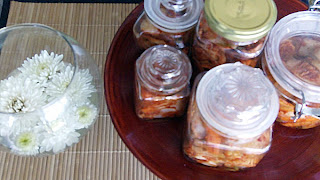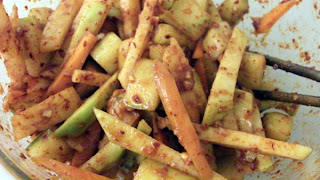Excited to share my Easy Kimchi and in Korea, they call it Kimchi Maki! Kimchi is the Korean way of pickling (fermenting) vegetables. I omit the rice flour and sugar. My personal preference is crispy, crunchy Kimchi before it ferments too much making it sour and soft. I start eating it the next day and go as fast as I can. I’m sure my Korean foodie friends would be horrified with this. It’s just what I like to do – turn recipes to suit my own taste and I encourage you to do the same, it’s so much fun.
However, I’ve provided a few links to other Kimchi recipes so you can choose how you want to make your kimchi or kimchee. Many recipes require you to make a ton, one starts with 10 pounds of cabbage!!!! To me, that makes cooking a chore and stresses me out thinking about the quantity. It takes TIME (always goes back to this), then finding/buying/cleaning jars to store it. No, no, we are not making this to resell, just as a little side dish to go with our dinner!
Try my Easy Kimchi and feel free to make your own variations, that’s what being a Wok Star is all about. Do share an unusual kimchi you’ve made. Hey, I didn’t even use a wok in this one!
Easy Kimchi
Use some or all of the following veggies:
1 whole medium size napa cabbage (wash & cut into bite size pieces)
All these are optionals, cut into julienne strips…
chayote, 1/2, peeled, deseeded
jicama, 1/2 small one, peeled
daikon, small handful
carrot, small handful
scallion 4-6 stalks
Salt for brining
Adjust seasonings to suit your taste:
3 tblsp. fish sauce
1 cup red pepper powder (do not mix this up with chili flakes! see photo below)
2 thumb size ginger minced
3-4 cloves garlic minced (optional)
Directions:
1. Gather utensils: big bowls, chopsticks, disposable gloves, 4-5 clean jars
2. Combine seasonings in small bowl
3. Wash all veggies, drain, chop. Put veggies in a big bowl covered with water and add salt, mix really well to coat. Leave to brine for a couple of hours.
4. Drain veggies in colander, put back into big bowl. Add seasoning and use gloves to massage till they soften a little. Divide into jars, don’t fill right to the top, put lids on.
5. Leave out for a day before refrigerating.
6. I start eating it right away, see if you’re not astounded how good it is!
I didn’t realize you could ‘kimchi’ anything. I always associated kimchi with napa cabbage cause that’s what we had with Bulgogi (Korean BBQ) growing up in Hong Kong.
Use disposable thin gloves for mixing. You don’t want to use your hands cause the red pepper powder is pretty spicy and discolors your hands. Don’t ever put your hands anywhere near your eyes after touching chilies!
Give it a taste, you want it to be a little bit salty, so add a little more fish sauce but be careful, cause a little goes a loooong way.
Mix all the veggies in a BIG bowl, otherwise you cannot combine well. Same concept when you use a wok that’s too small, you can’t stir fry properly, your food doesn’t cook evenly and is frustrating because your food keeps falling out. (I had to get this tip in about size of your wok!)
 I bottle in cute jars so you can give to your friends. I end up eating it so fast, never gets a chance to get out the door!
I bottle in cute jars so you can give to your friends. I end up eating it so fast, never gets a chance to get out the door! Goes well with your one-dish wok meals (unless it’s a curry already)
Goes well with your one-dish wok meals (unless it’s a curry already)Tip: If you have leftover seasoning, store in a container or zip loc and freeze it for another batch.
There’s even a chef who calls himself a lactofermentation and pickling instructor who started a Kimchi Festival in Boston!
This blogger has really impressed me with his food adventures, considering he started late in life.
We cannot mention kimchi without mentioning this youtube celebrity, here’s her video and her kimchi!
Here’s my Korean twitter buddie’s authentic version, scroll down for kimchi.
If you live in Miami, Little River Garden gives Kimchee workshops! Found out from Mango and Lime after she went to one.
UPDATE 5.5.11: I’m excited to see a new PBS TV show that’s not a reality cooking show or a chef competition coming this summer starring chef Jean Georges-Vongerichten’s wife, Marja. Watch a preview clip of Kimchi Chronicles




